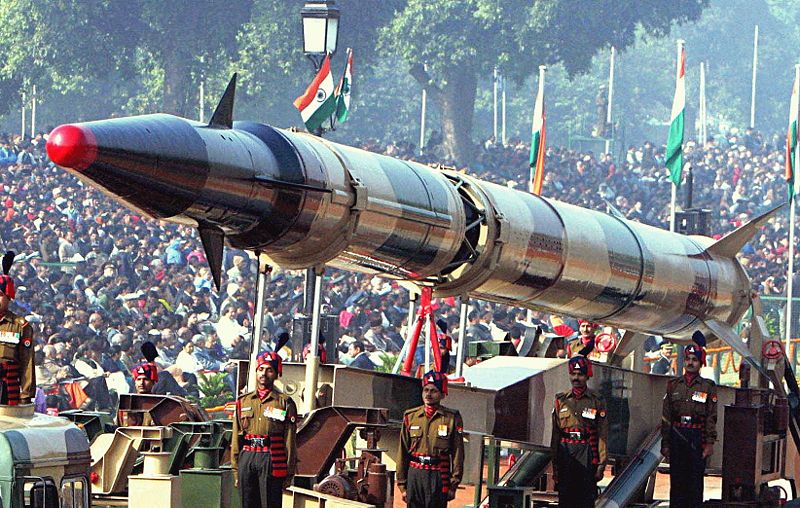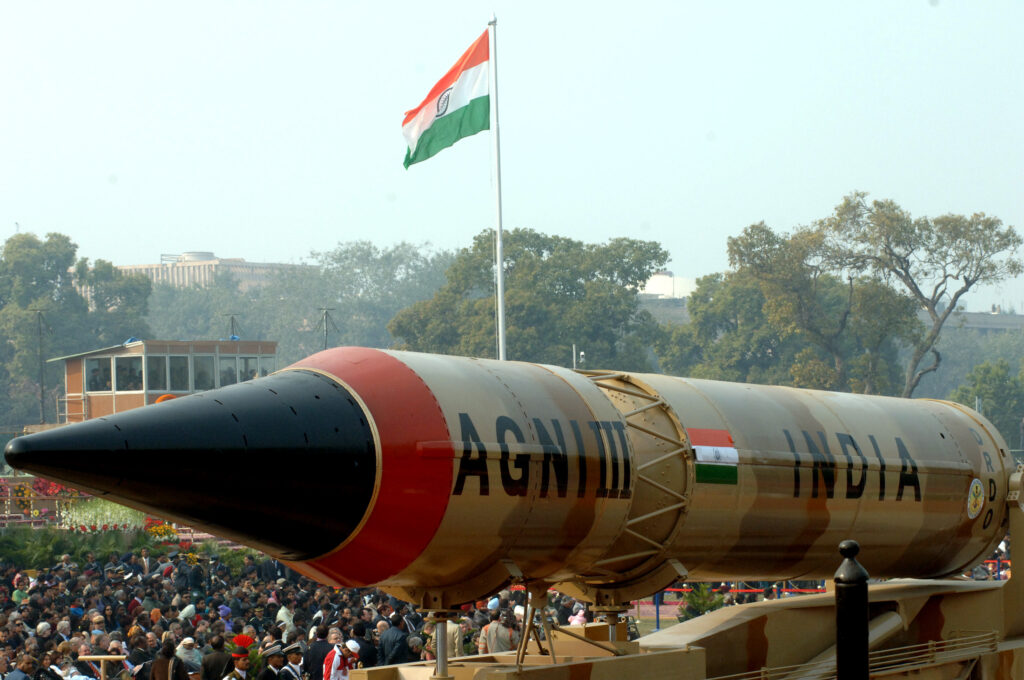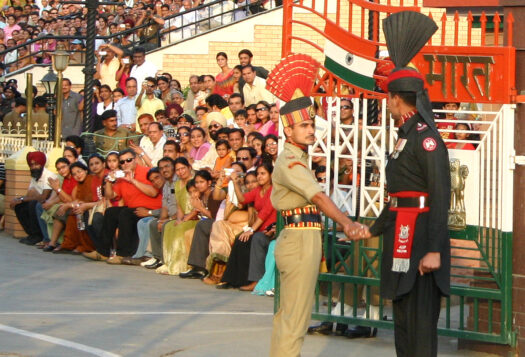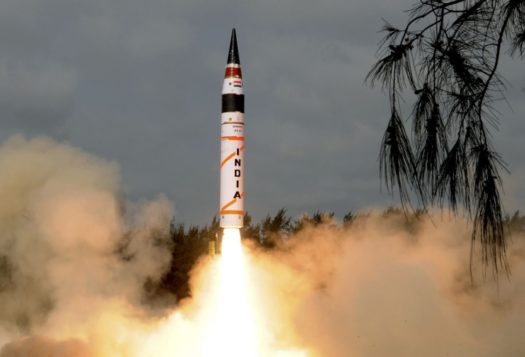
On March 11, 2024, India’s Defense Research and Development Organization (DRDO) announced the successful test of a land-based nuclear missile equipped with Multiple Independently Targetable Re-entry Vehicle (MIRV) technology. The missile test, named Mission Divyastra, launched from Dr. APJ Abdul Kalam Island in the Indian state of Odisha, positioning India among the select nations possessing MIRV capability. This exclusive club includes the United States, United Kingdom, Russia, China, and France. Notably, Pakistan conducted its maiden MIRV test in January 2017, employing the Ababeel medium-range ballistic missile.
The officially stated range of the Agni-V is 3,106 miles. Nonetheless, analysts speculated, even at the time of the first test in 2012, that this is an intercontinental ballistic missile (ICBM) with a range of up to 4,790 miles. This range would cover not just the entire Chinese landmass, including its eastern seaboard, but also some parts of Europe and Africa. Given the DRDO’s particular focus over the years on reducing the weight of Agni-V by replacing heavier sub-systems with lightweight composite materials, some analysts suggest that the missile may be capable of reaching beyond the 4,970 mile range. Agni-VI, still in development, is likely to have a range of up to 6,213 miles, thereby reaching as far as some parts of the United States and Canada.
Measured Significance for India
The latest test is the tenth test of Agni-V, but the first with MIRV technology. With MIRV technology, a single missile can carry multiple warheads with independent guidance systems and navigation controls that are capable of independent targeting at varying speeds and distances spanning hundreds of miles apart. According to Indian sources, the Agni-V MIRV has an indigenous avionics systems and contains high-precision sensor packages to ensure precise targeting. The official statement following the test did not specify the number of warheads, but it is generally believed that it can carry four to six warheads, whereas some estimates even claim the number of warheads to be up to 10 to 12.
India’s Defense Research and Development Organization (DRDO) announced the successful test of a land-based nuclear missile equipped with Multiple Independently Targetable Re-entry Vehicle (MIRV) technology.
The testing of the MIRV-capable Agni-V is an important milestone for India but not a technological marvel per se, since the technology has existed since the late 1960s. The United States was the first country to deploy a MIRVed ICBM in 1970, followed by the Soviet Union. Observers even speculated that India’s purportedly Pakistan-specific Agni-P medium-range missile, launched in December 2021, carried two reentry vehicles to test the MIRV capability. According to unconfirmed reports, the Agni-V user trial in October 2021 was also equipped with MIRVs. The latest Agni-V test, however, did not carry any decoy warheads; it only demonstrated the MIRV technology.
The timing and projection of the news surrounding the latest test are indeed notable. Similar to the Anti-Satellite (ASAT) test conducted before the 2019 elections, domestic and international observers expected a technological demonstration of the same level ahead of upcoming elections. While the BJP-led government is hailing it as a significant development, it’s important to acknowledge that operationalizing this technology will require numerous additional tests. This is especially pertinent given the fact that achieving successful miniaturization of warheads suitable for MIRVing capabilities took the United States and the Soviet Union several years.

Regional Implications
The latest test is supposedly a response to China, as India’s existing missile ranges already cover the entire landmass of Pakistan. But regardless of the declaratory intent, the test is likely to impact Pakistan’s strategic thinking in a significant manner. Pakistan’s first reaction was to raise its concern over New Delhi’s failure to adhere to the missile notification agreement which, according to the Foreign Office spokesperson, was not followed in letter and spirit. According to the statement, “The advance notification was shared by India, but it did not follow the 3-day timeline as stipulated in Article 2 of the Agreement on Pre-notification of the Fight Testing of Ballistic Missiles.”
MIRVing is an offensive strategy in nature and was largely viewed as a first strike weapon during the Cold War. In that regard, claiming that this will enhance deterrence is rather misplaced, especially given its potential to exacerbate the security dilemma between India and Pakistan. Furthermore, it has the potential to spark an expensive arms race in the region.
On the other hand, it presents a disadvantage by enabling an adversary to more easily neutralize multiple warheads with a strike against a single target, thereby undermining deterrence. Additionally, while MIRVing could potentially serve as an effective countermeasure against a Ballistic Missile Defense (BMD) system, it is worth noting that Pakistan does not have a BMD, and China’s BMD capability is not a dominant factor in the India-China deterrence dynamic as it is mainly positioned against the U.S. missile threat. As duly noted by Hans Kristian, “Unless China develops an efficient missile defense system with capability against intermediate-range ballistic missiles, there seems to be no military need for MIRVs on Indian missiles.” Similarly, Agni-V is primarily designed to cover the entire landmass of China; equipping it with MIRVs will increase its weight, which will reduce its range, thereby undermining its primary deterrent role against China.
Pakistan’s response is likely to be diversifying its nuclear options and perfecting its own MIRV capability.
The MIRVing of Agni-V further erodes the sanctity of India’s nuclear doctrine. New Delhi’s official nuclear policy is centered around the principles of credible minimum deterrence and assured retaliation. However, its recent strides into MIRVing contradicts the notion of minimum deterrence and defensive posturing. If anything, the test is a further confirmation of India’s evolving nuclear posture in its bid to shift to counterforce targeting against Pakistan. In 2019, Christopher Clary and Vipin Narang noted that “if India used MIRVed missiles intended for China against Pakistan (by lofting or depressing their missile trajectories), what it pursues for survivability against the former could be employed as a potential first-strike weapon against the latter.”
This development is going to intensify the nuclear arms competition and give incentive to a dangerous warhead race in South Asia. Looking ahead, Pakistan’s response is likely to be diversifying its nuclear options and perfecting its own MIRV capability. These developments will further undermine an already fragile regional stability between New Delhi and Islamabad by generating first-strike instability where each side will be incentivized to attack first. It was this risk to stability that pushed the United States to call for the de-MIRVing of its ICBMs in its tenth nuclear posture review in 2010. In the absence of reliable risk reduction measures and crisis de-escalation mechanisms in South Asia, every crisis runs the risk of escalating, whether intentionally or unintentionally, to the nuclear threshold. With the employment of MIRVs, that risk rises a few notches up.
Also Read: Emerging Missile Technologies: A New Arms Race in South Asia?
***
Click here to read this article in Urdu.
Image 1: Agni Missile via Wikimedia Commons.
Image 2: Agni-III via Flickr.


